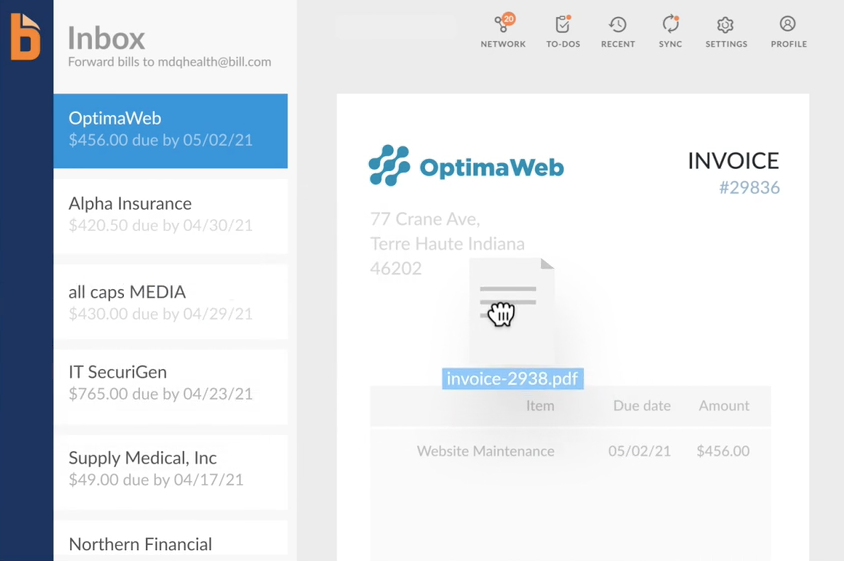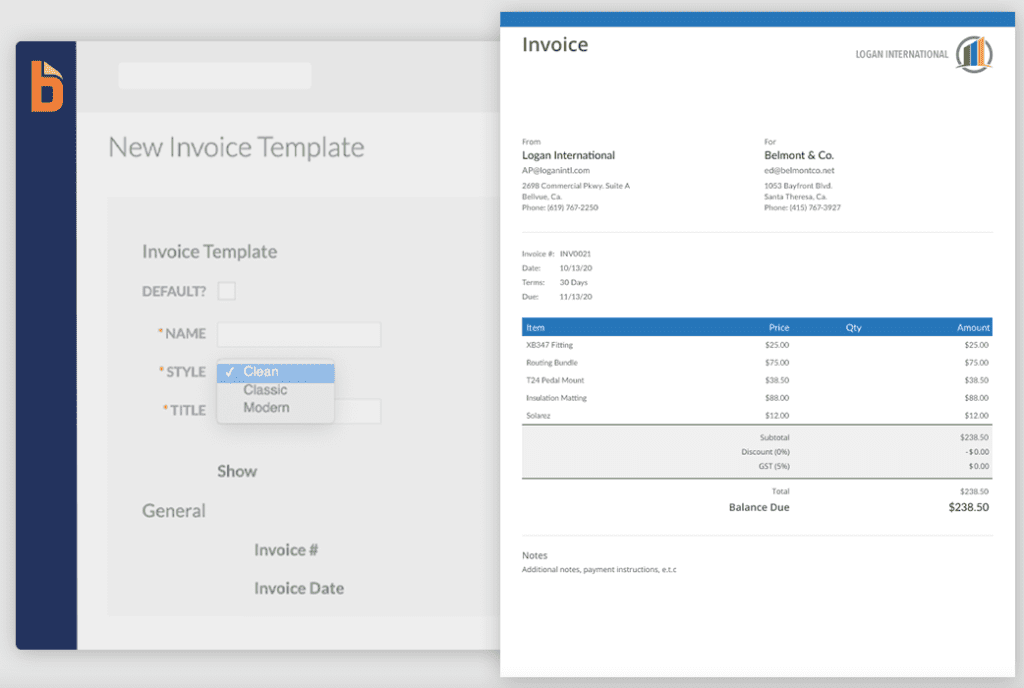Bill.com is a solution for automating your accounts payable and receivables that integrates with cloud-based accounting software like QuickBooks. While Bill.com has some unique features, competitors like Sourcery can offer a more dynamic and customizable solution based on your specific needs.
Here’s what you need to know about these innovations for your office tools, including which one might be right for you.
Bill.com Features
Bill.com offers a wide range of features to help businesses effectively manage their accounts payable and receivables workflows. Here are some of the key features of Bill.com:
Accounts Payable Automation
Bill.com automates the accounts payable process by capturing invoices, scanning them, and submitting them for approval. The process of automating accounts payable begins with capturing invoices by scanning or emailing them to a specific email address, then scanning them to retrieve relevant information.
Bill.com has a feature called Inbox that allows suppliers to electronically send their invoices to a unique email address created by Bill.com.

Bill.com Inbox (Source: Bill.com)
After a supplier sends invoices to your Bill.com email inbox, the program will automatically extract relevant information from the invoice, including the invoice number, date, amount owed, and due date. This information will be used to create a digital invoice record that can be easily accessed and managed from within the Bill.com platform.
Once the invoice is in the system, you can review and approve the payment, set up payment schedules, and even send the payment directly through the Bill.com platform. By automating this process, you can save time, reduce errors, and improve the efficiency of your accounts payable workflows.
Accounts Receivable Automation
Bill.com makes it easy to create invoices by providing invoice templates or the ability to upload your own.

Sample invoice template on Bill.com (Source: Bill.com)
Once created, invoices can be sent electronically via email, and businesses can track their status in real time through Bill.com. Once an invoice is sent, Bill.com automates the payment processing process, allowing customers to pay electronically via ACH or credit card, and providing businesses with real-time payment tracking.
Bill.com also allows businesses to schedule recurring invoices that can be automatically sent to customers on a regular basis. Additionally, it can send automatic reminders to customers with unpaid invoices, reducing the need for manual follow-up.
Document Management
With Bill.com, you can store and manage invoices, receipts, packing slips, and other financial documents in a centralized location, making it easy to find and retrieve documents when needed. Bill.com’s document management feature enables electronic document storage and eliminates the need for paper documents, reducing manual labor and improving efficiency.
Companies can upload documents directly to Bill.com or register them by scanning them and sending them to a designated email address. Once uploaded or registered, documents are digitized, making them easy to find and retrieve using Bill.com’s advanced search capabilities.
Customizable Approval Workflows
Bill.com approval workflows can be customized to fit each company’s approval process, including multiple approval levels and specific rules for different document types. Users are tasked with approving invoices based on their role within the organization. For example, an invoice can be automatically sent to a manager for approval before being sent to the finance department for final approval. This allows companies to maintain tight control over their approval process, ensuring that invoices are only paid after they have been approved by the appropriate parties.
Custom rules can also be configured within Bill.com approval workflows. These rules can be based on criteria such as invoice amount, vendor, or department, and can determine which users are responsible for approving certain invoices. For example, an invoice above a certain dollar amount can be automatically sent to a manager for approval.

Creating Invoice Approval Workflows in Bill.com (Source: Bill.com)
Bill.com approval workflows allow businesses to track the approval process in real time and receive notifications when invoices are approved. This gives businesses real-time visibility into their financial transactions and helps ensure that invoices are paid on time.
Automatic Bill Codification
One of the best features of Bill.com is that it learns from past transactions, allowing the system to automatically assign the correct general ledger (GL) codes based on the company’s historical data. As invoices are entered into Bill.com, the system analyzes past transactions to identify patterns and set rules for automatic invoice coding. For example, if a company consistently assigns a GL code to invoices from a particular supplier, the system will learn this pattern and automatically apply the same code to future invoices from that supplier.
The system also takes into account any changes made by the user to the GL codes during the approval process. If the user changes the general ledger code assigned by the system, it learns from this change and applies it to future invoices with similar criteria.
Automatic invoice coding saves time by eliminating the need to manually categorize invoices. It also reduces the risk of errors by ensuring that invoices are consistently categorized and assigned the correct general ledger codes. Finally, it provides companies with real-time visibility into their financial transactions, making it easier to track costs and analyze spending patterns.
Reporting & Analytics
With Bill.com, you can create custom reports based on specific criteria, such as vendor, expense category, or project. Reports can be generated in a variety of formats, including PDF, CSV, and Excel, and can be easily exported to accounting software or shared with stakeholders.
In addition to creating custom reports, Bill.com offers companies a dashboard that displays key financial metrics, such as cash flow, outstanding invoices, and payables. The dashboard also provides visual representations of data, such as charts and graphs, making it easy for businesses to identify trends and patterns in their financial data.
What to Look for in Accounts Payable/Receivable Solutions
An automated accounting solution can help you streamline your office management. It’s a way to collect payments faster and manage accounts more efficiently. However, there are a wide variety of solutions to choose from. Some, like Bill.com, focus almost exclusively on digital invoicing, automated payments, and account reconciliation.
Others, like Sourcery, are comprehensive solutions that include vendor management as well as efficient invoicing and automated reconciliation. Specifically designed for the restaurant industry as well as small startups, Sourcery offers specialized product ordering and receiving capabilities that Bill.com lacks.
When looking for the right platform, you may need to decide whether you need just an invoicing tool or a comprehensive account management solution.
Bill.com Overview and Features
True to its name, Bill.com’s main function is to facilitate domestic and international payments. It covers all aspects of accounts payable, including electronic invoicing and various money transfer features.
With Bill.com, you can receive digital invoices from suppliers and ensure quick approval. You can also create and issue invoices to your customers and receive payments via ACH, ePayment, PayPal, or credit card. The platform easily syncs with major accounting software, such as Oracle, Xero, QuickBooks, and Sage.
Bill.com Reviews and Pricing
Bill.com has generally positive reviews. Users appreciate the automated features and ease of payment approval. Some Capterra users noted that the preview window could be improved. Others noted sync issues and limited rules capabilities. PC Mag noted that it doesn’t work as a double-entry system and therefore may seem lacking in features. However, the magazine emphasized that Bill.com doesn’t try to do everything that other solutions do.
Some users on G2crowd have reported frequent errors when syncing with accounting software. One recent review complained about poor customer service, as they had an unresolved issue with their account and had not received a response from Bill.com’s chat or the ability to call the company. Overall, Bill.com has a good reputation, but some users were not happy with paying more for additional features, such as automatic invoice entry.
Pricing plans range from $29 to $59 per user per month, with the latter being the most popular. In addition, the platform charges $19 per “referral” user. There are additional transaction fees, including $0.49 for electronic payments, $0.49 per invoice for auto-entry, $0.99 for PayPal payments, and $9.99 to $19.99 for expedited payments.
Sourcery Overview and Features
While Bill.com focuses on payments, Sourcery offers a number of benefits to restaurants and small businesses. These include automatic invoicing, online invoice payments, internal ACH, and domestic and international check processing. It integrates with Xero, QuickBooks, Sage, and other major software.
Sourcery has extensive vendor management capabilities that allow for online ordering. The software is designed for food businesses that often have to amend invoices or issue credit memos due to damaged items in shipping. With Sourcery, these changes are simple and hassle-free. The platform facilitates quick communication with suppliers, avoiding time-consuming manual and outdated ordering processes.
In addition, automated invoice scanning turns into actionable data. Restaurants receive the necessary cost analysis. The platform offers price alerts that allow owners to better control their spending on perishable ingredients. Thanks to this functionality, Sourcery can help customers make important business decisions and balance their accounts.
Sourcery has a strong customer support team. Each Sourcery customer has a dedicated account manager who will help them with any issues. The support team is always available to each user so that customers can fully enjoy all the features of the product.
How to Evaluate Which is Best
To help you choose the best solution for your needs, it’s helpful to review some of the key advantages and disadvantages of each platform.
Bill.com
Pros: Bill.com does a great job of automating invoices and making payments more efficient. Approval processes are straightforward. The platform has extensive international payment options.
Cons: The subscription is per user, and there are additional transaction fees. Some users have complained that Bill.com’s integration with their accounting software isn’t as seamless as they would like. Others have complained about the lack of customer service.
Sourcery
Pros: Sourcery is specifically designed for restaurant owners. It offers powerful inventory analysis and price changes so owners can control costs. It offers invoice scanning, similar to Bill.com, and also includes payment options. Its direct ordering feature streamlines relationships with suppliers. Customer service and predictable pricing round out the platform’s strengths. Cons: Since it doesn’t specifically focus on accounts payable functionality, it can take a while to learn all of its features.
Perhaps the best way to determine the most effective platform for your business is to try it out. Contact Sourcery today and schedule a free demo to see if the product can help improve your business’s efficiency and success.


